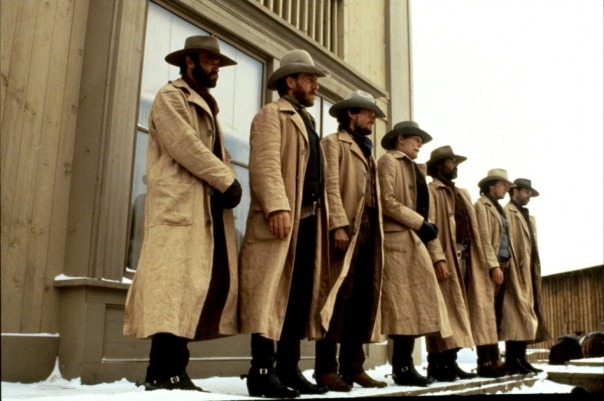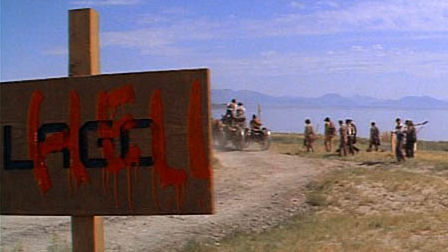Eastwood’s avenging angels
Clint Eastwood seemed fond of a particular Western story in the 70s and 80s – albeit not as keen as Howard Hawks with his own repeated themes in the Rio Bravo / El Dorado/ Rio Lobo trilogy – but keen nonetheless. Eastwood’s story is that of a perhaps supernatural stranger who comes to town to punish bad people for past deeds, or indeed the wrong they have done to the stranger in particular.
High Plains Drifter (1973) and Pale Rider (1985) are the films in point, and are startlingly similar – even if the latter is the more polished of the two (as expected given Eastwood’s progress in the director’s chair). It’s frustrating that the second is sometimes accused of being a shoddy copycat version of genre classic Shane (1953), whereas it’s a deeper and more mature reworking of Drifter’s rough diamond. In fact, some of gone so far to say that Eastwood’s preacher in Rider is the same character as the mysterious stranger in Drifter.
Rider is the more cryptic of the two with scant attention given to the backstory of the preacher, and his grudge with sadistic gun-for-hire Stockburn (played wonderfully by a gaunt-looking John Russell, incidentally the villain in Hawks’ Rio Bravo (1959)). I’ve always felt that the main plot in Rider, of the competing interests of tin-pan miners and a ruthless company with technologically advanced methods is just an excuse to generate the showdown between Stockburn and the preacher himself – and the inevitable revelation that Stockburn’s dollar driven sadism cannot go unpunished even in a land as lawless as the West. Drifter offers more in terms of contextual backdrop with elongated flash-back sequences detailing the whole town witness a murder they engineered to save the livelihoods they have built.

In Rider and Drifter, concentration is laid on the reactions of the other characters to the arrival of the stranger. In Rider, the reaction of Michael Moriarty and his tin-pan community is one of growing hope – literally seeing Eastwood as a kind of saviour. Stockburn’s reaction is one of cautious foreboding, sensing a confrontation which has long been coming. In Drifter, the response of the townsfolk is similar to the tin-pans initially, but gradually shifts toward a more ominous feeling.
The personalities of the stranger in the two companion pieces are actually rather opposite – in Drifter, our anti-hero is darker and even cruel at times, whereas in Rider the stranger is more ‘just’. Within the first ten minutes of Drifter, our stranger has shot 3 people and raped a woman in a scene which by today’s standards would be uncomfortable for many. More generally, Rider is less violent and less brutal than the dirtier Drifter which is jammed with unlikeable characters played to the hilt by an awesome patchwork of a cast (Geoffrey Lewis, Anthony James, Mitchell Ryan, Walter Barnes and of course the memorable Billy Curtis as the sole goody guy).

The supernatural nature of the stranger in both films is somewhat disputed, but to me seems indisputable in Rider at least. Stockburn’s weathered reaction to the preacher’s description, and his shock-ridden eyes when he comes face to face with Eastwood in the finale seems to confirm it. The ending of Rider and Drifter both show the stranger disappear into the distance, nearly dissipating into the landscape like the spectres they are implied to be. Both film’s scores have the feel of the supernatural about them too, particularly Drifter’s sloping introductory and closing pieces. The religious symbolism is overtly obvious in Rider -with Eastwood’s stranger himself being ‘summoned’ onto the screen as Sydney Penny reads out a bible verse about the 4 horsemen of the apocalypse – but also apparent in Drifter. Our stranger here changes the town’s name from Lago to ‘Hell’, forces the townsfolk to paint the buildings blood red and confronts Lago’s gutless and sanctimonious preacher.
Eastwood’s camerawork in Rider is better than in Drifter; and his manipulation of the set-pieces has come on leaps and bounds between 1973 and 1985 with the ending coda to Rider being one of the best Western set-pieces of modern times. That doesn’t automatically mean the Rider is the superior film, and it admittedly lacks the punch of Drifter and its bluntly revisionist stance built on a pernicious anti-hero. But these are two great movies, which are really extensions of one another.
Posted on May 7, 2017, in Uncategorized. Bookmark the permalink. Leave a comment.
Leave a comment
Comments 0